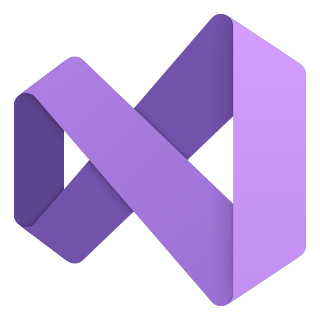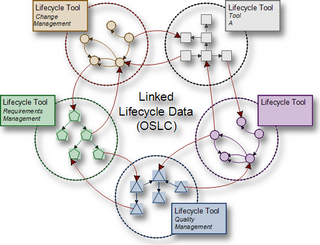
OSGi is an open specification and open source project under the Eclipse Foundation.
A web container is the component of a web server that interacts with Jakarta Servlets. A web container is responsible for managing the lifecycle of servlets, mapping a URL to a particular servlet and ensuring that the URL requester has the correct access-rights. A web container handles requests to servlets, Jakarta Server Pages (JSP) files, and other types of files that include server-side code. The Web container creates servlet instances, loads and unloads servlets, creates and manages request and response objects, and performs other servlet-management tasks. A web container implements the web component contract of the Jakarta EE architecture. This architecture specifies a runtime environment for additional web components, including security, concurrency, lifecycle management, transaction, deployment, and other services.

Eclipse is an integrated development environment (IDE) used in computer programming. It contains a base workspace and an extensible plug-in system for customizing the environment. It is the second-most-popular IDE for Java development, and, until 2016, was the most popular. Eclipse is written mostly in Java and its primary use is for developing Java applications, but it may also be used to develop applications in other programming languages via plug-ins, including Ada, ABAP, C, C++, C#, Clojure, COBOL, D, Erlang, Fortran, Groovy, Haskell, JavaScript, Julia, Lasso, Lua, NATURAL, Perl, PHP, Prolog, Python, R, Ruby, Rust, Scala, and Scheme. It can also be used to develop documents with LaTeX and packages for the software Mathematica. Development environments include the Eclipse Java development tools (JDT) for Java and Scala, Eclipse CDT for C/C++, and Eclipse PDT for PHP, among others.
Maven is a build automation tool used primarily for Java projects. Maven can also be used to build and manage projects written in C#, Ruby, Scala, and other languages. The Maven project is hosted by The Apache Software Foundation, where it was formerly part of the Jakarta Project.
Eclipse Jetty is a Java web server and Java Servlet container. While web servers are usually associated with serving documents to people, Jetty is now often used for machine to machine communications, usually within larger software frameworks. Jetty is developed as a free and open source project as part of the Eclipse Foundation. The web server is used in products such as Apache ActiveMQ, Alfresco, Scalatra, Apache Geronimo, Apache Maven, Apache Spark, Google App Engine, Eclipse, FUSE, iDempiere, Twitter's Streaming API and Zimbra. Jetty is also the server in open source projects such as Lift, Eucalyptus, OpenNMS, Red5, Hadoop and I2P. Jetty supports the latest Java Servlet API as well as protocols HTTP/2 and WebSocket.
Laminas Project is an open source, object-oriented web application framework implemented in PHP 7 and licensed under the New BSD License. The framework is basically a collection of professional PHP-based packages. The framework uses various packages by the use of Composer as part of its package dependency managers; some of them are PHPUnit for testing all packages, Travis CI for continuous Integration Services. Laminas provides to users a support of the model–view–controller (MVC) in combination with Front Controller solution. MVC implementation in Laminas has five main areas. The router and dispatcher functions to decide which controller to run based on data from URL, and controller functions in combination with the model and view to develop and create the final web page.
Model-driven engineering (MDE) is a software development methodology that focuses on creating and exploiting domain models, which are conceptual models of all the topics related to a specific problem. Hence, it highlights and aims at abstract representations of the knowledge and activities that govern a particular application domain, rather than the computing concepts.

Google Web Toolkit, or GWT Web Toolkit, is an open-source set of tools that allows web developers to create and maintain JavaScript front-end applications in Java. It is licensed under Apache License 2.0.
Application lifecycle management (ALM) is the product lifecycle management of computer programs. It encompasses requirements management, software architecture, computer programming, software testing, software maintenance, change management, continuous integration, project management, and release management.

Microsoft Silverlight is a discontinued application framework designed for writing and running rich internet applications, similar to Adobe's runtime, Adobe Flash. While early versions of Silverlight focused on streaming media, later versions supported multimedia, graphics, and animation, and gave support to developers for CLI languages and development tools. Silverlight was one of the two application development platforms for Windows Phone, but web pages using Silverlight did not run on the Windows Phone or Windows Mobile versions of Internet Explorer, as there was no Silverlight plugin for Internet Explorer on those platforms.

Xmind is a mind mapping and brainstorming software, It is developed by XMIND LTD, a company registered in Hong Kong, and first released in 2007. The application can be used to visualize ideas, clarify thoughts, manage complex information, and promote team collaboration. People use Xmind to improve their productivity and creativity while working or learning. As of April 2013, Xmind was selected as the most popular mind mapping software on Lifehacker. There is also a branch in China Mainland called "深圳市爱思软件技术有限公司", although its role in XMind cannot be confirmed.

Visual Studio is an integrated development environment (IDE) developed by Microsoft. It is used to develop computer programs including websites, web apps, web services and mobile apps. Visual Studio uses Microsoft software development platforms including Windows API, Windows Forms, Windows Presentation Foundation (WPF), Windows Store and Microsoft Silverlight. It can produce both native code and managed code.
Virgo is an open source, OSGi-based, Java application server. Virgo supports the deployment of OSGi bundles and unmodified Java web applications as well as OSGi-influenced Shared Libraries WARs and Shared Services WARs.

Open Services for Lifecycle Collaboration (OSLC) is an open community, originally proposed in 2008, to define a set of specifications that enable integration of software development. It has evolved, and continues to evolve, to areas such as Application Lifecycle Management (ALM), Product Lifecycle Management (PLM), IT Operations and more. The intention is to make life easier for tools users and tools vendors, by making it easier for tools to work together.

Cloud Foundry is an open source, multi-cloud application platform as a service (PaaS) governed by the Cloud Foundry Foundation, a 501(c)(6) organization.
Topology and Orchestration Specification for Cloud Applications (TOSCA) is an OASIS standard language to describe a topology of cloud based web services, their components, relationships, and the processes that manage them. The TOSCA standard includes specifications of a file archive format called CSAR.

Electron is a free and open-source software framework developed and maintained by OpenJS Foundation. The framework is designed to create desktop applications using web technologies that are rendered using a version of the Chromium browser engine and a back end using the Node.js runtime environment. It also uses various APIs to enable functionality such as native integration with Node.js services and an inter-process communication module.
Tuleap is an application lifecycle management system which facilitates agile software development, design projects, V-model, Requirement Management, and IT Services Management. It is open source, released under the GNU General Public License, version 2.







